Are you subscribed to a satellite internet service provider such as Viasat, Starlink, or HughesNet? If you’re unhappy with your ISP-provided router’s speed, coverage, or customization options, I’ll help find an ideal replacement.
While cable or fiber internet is much better, satellite internet has its perks. For instance, you don’t need a high-end expensive WiFi router. Any decent budget device would do. However, the availability of so many options can trick you and you might end up getting a subpar device that hampers your overall experience.
That’s why I took 14 routers suitable for satellite internet and tested each for a week on various performance standards. These include speeds at different locations, signal strength, device handling ability, security controls, and more. Out of 14, only 7 options breezed through my tests and made it to the list.
7 Best Satellite Internet Routers of 2024
To give you an overview of the list, I have included the most feature-packed and premium models at the top, gradually moving on to mid-tier, and ending with the budget options. Let’s get into their detailed reviews!
1. Best Overall: TP-Link Archer AXE75
- Wireless Standard: Wi-Fi 6E (802.11ax)
- Band Frequency: Tri-Band
- WiFi Range: Up to 2,500 Sq Ft
- Number of Devices Supported: 200
- Ports: 1 x Gig WAN + 4 x Gig LAN + 1 x USB 3.0
If you’re willing to hop onto a WiFi 6E router but don’t want to invest exorbitant money, TP-Link Archer AXE75 is your best bet. Available for just $200, this tri-band routing device delivers top-tier performance in all aspects.
Compared to its predecessor, Archer AX73, it has done an overhaul in terms of features and performance. Let’s understand how it performs in real-world situations.
Speeds & Performance
The Archer AXE75 comes with a new uncongested 6 GHz band and can deliver a maximum throughput of 5400 Mbps, which is split among its bands as follows:
| 6 GHz: 2402 Mbps | 5 GHz: 2402 Mbps | 2.4 GHz: 574 Mbps |
With such a high throughput capacity, it seems fair to pair the router with the best available, i.e., the Starlink Priority plan with a speed of up to 500 Mbps. And the results were impressive over the auto-band-selection setup.
The speed test at 20 feet transpired at the rate of 402 Mbps in download. At the same time, the upload speed is valued at 32 Mbps.
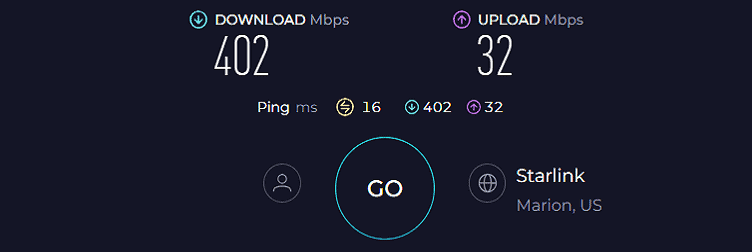
Moving to a 50 feet distance dropped the speeds to 241 Mbps and 19 Mbps, respectively for downloads and uploads.
With such available speeds, I could indulge in PS5 gaming, and two TVs streaming on Netflix and YouTube, alongside low-bandwidth tasks like web browsing, surfing social media, and more.
Besides, the router entails Gigabit Ethernet ports that give you access to much faster speeds and in turn better performance.
WiFi Coverage & Devices Capacity
To test its wireless signal strength and maximum range, I installed this router on the outskirts of my 2,500 Sq Ft lab. While it’s hard to tell it in numbers, its six antenna setup could encase an area of around 2,250 Sq Ft.
The best part is that the transmitted signals were clean and stable with the availability of multiple free channels in the 6 GHz band.
At a stretch, I could connect up to 65 devices, but you can add a few more, with its maximum capacity standing at 200. The MU-MIMO, beamforming, and OFDMA technologies work wonders when it comes to handling multiple devices.
Security Features
The Archer AXE75 comes with a basic HomeShield security suite. It includes WPA3 and VPN which keeps the data transferred over the network in an encrypted form and lets you access any website without compromising your identity.
Also, there are features like guest access, access control, and auto-firmware updates. The parental controls, as opposed to its security features, let you apply age-based filters, block internet access, and monitor the hours a user is online.
Besides, you can create time rewards to give your kids some extra time as a reward for completing their homework or any household chores.
Conclusion
Overall, TP-Link Archer AXE75 with WiFi 6E and tri-band operation, ease of use, and top-shelf performance is a futuristic router that retails for $200. It suits everyone, whether a gamer, streamer or a family with working professionals.
To learn more, read my full review of the TP-Link Archer AXE75.
- Future-proof standards
- 6 GHz WiFi transmission
- Solid network performance
- Handles many devices
- Great WiFi range
- Easy to install & manage
- No multi-gig port
2. Best Runner-Up: ASUS RT-AX5400
- Wireless Standard: Wi-Fi 6 (802.11ax)
- Band Frequency: Dual-Band
- WiFi Range: Up to 2,500 Sq Ft
- Number of Devices Supported: 30+
- Ports: 1 x Gig WAN + 4 x Gig LAN + 1 x USB 3.0
ASUS RT-AX5400 entails the same throughput, WiFi range, and port setup as my previous pick but costs $60 less. If you don’t need a tri-band WiFi 6E setup, it’s a great router for satellite internet. Besides, it takes away all security concerns with its lifetime-free AiProtection Pro commercial-grade security.
Furthermore, RT-AX5400 takes precedence over its preceding model, RT-AX3000 (AX58U) in terms of throughput capacity, range, and others.
Internet Speeds
The RT-AX5400, as the name suggests, has a throughput capacity of 5400 Mbps, which is distributed over the two bands as follows:
| 5 GHz: 4804 Mbps | 2.4 GHz: 574 Mbps |
I paired the router with the Starlink premium business plan and measured the download and upload speeds over two different locations.
The results were impressive considering the 5 GHz band active at a 20 feet distance clocked a download speed of 231 Mbps and an upload speed of 38 Mbps.
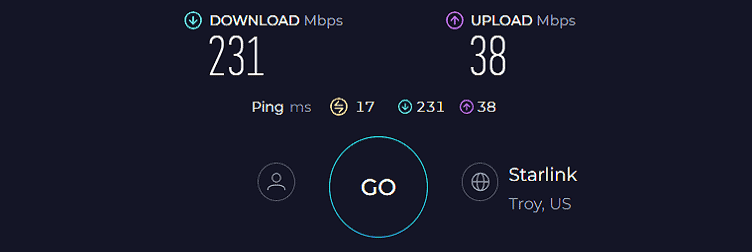
Upon moving to a 50 feet distance, the speeds dropped to 139 Mbps and 21 Mbps for downloads and uploads, respectively.
The speeds paired with QoS my overnight gaming sessions on my PS5, and it also breezed through my simultaneous web surfing on smartphones and streaming on TVs. I didn’t experience any lags or stutters, all the activities ran buttery smooth.
WiFi Coverage & Devices Capacity
The four antennas with beamforming support aren’t the most flexible but claim to be ideal for 2,500 square feet homes. In my tests, the ASUS router could impart signals to an area of approximately 2,200 Sq Ft when placed centrally.
Even after hogging the network with 35 connections, the devices got coherent signals on each, thanks to MU-MIMO and OFDMA. Besides, the signals were smooth even high-end activities were undertaken on the network.
Security Features
Security is the USP of this sub $150 router. It has got AiProtection Pro, powered by Trend Micro that doesn’t require a single penny.
It has some advanced features to eliminate infected devices, block malicious websites, and prevent intrusions. Aside from that, ASUS Instant Guard VPN, a device block list, access filters, and weekly scan reports add a few points to it.
And as usual, there are basic features like WPA3, VPN, and guest access.
Conclusion
Overall, the Asus RT-AX5400 with advanced security features, Wi-Fi 6, and reliable performance justifies the hype it creates amongst budget wireless routers. It’s a great device for any satellite internet plan and gets most of your internet-bound tasks like gaming, streaming, and others.
- Great throughput and speeds
- Lifetime free AiProtection Pro
- Advanced parental controls
- Decent range & AiMesh support
- QoS for traffic prioritization
- Middling device handling support
3. Best for HughesNet: Linksys Hydra 6
- Wireless Standard: Wi-Fi 6 (802.11ax)
- Band Frequency: Dual-Band
- WiFi Range: Up to 2,000 Sq Ft
- Number of Devices Supported: 30+
- Ports: 1 x Gig WAN + 4 x Gig LAN + 1 x USB 3.0
If you want to take the speed benefits of Wi-Fi 6 but can’t spend a load of money, Linksys Hydra 6 could be the choice. It puts four antennas and other networking technologies like QoS, MU-MIMO, and OFDMA to establish seamless connectivity across your satellite internet connection.
Besides, compared to Linksys MR6350, it brings speed, range, and overall performance upgrades.
Wireless Speeds
Linksys Hydra 6 bestows an identical throughput capacity of 3000 Mbps, and the respective speed on each band is as follows:
| 5 GHz: 2401 Mbps | 2.4 GHz: 574 Mbps |
To gauge the WiFi router’s performance, I used the Fusion 200 GB plan from HughesNet and my MacBook Pro 16″ as the testing setup.
At a distance of 20 feet, it yielded 44 Mbps for downloads and 20 Mbps for uploads.
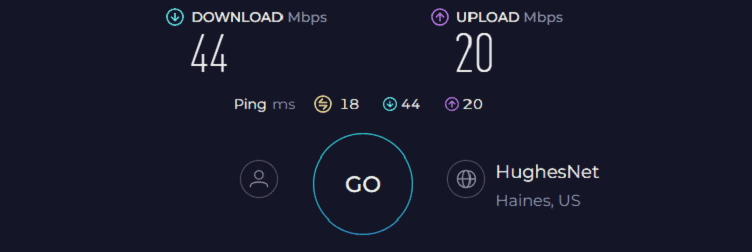
While separating the Hydra 6 and test system by 50 feet, the respective speeds moved to 27 Mbps and 12 Mbps.
Over my week of using it as a primary router, the routing unit passed through an informal saturation test where I sent & received email, streamed music, browsed the web, and sent messages to my colleague on multiple devices at once.
Besides, it is a QoS-supported router, so you can prioritize any traffic if needed.
WiFi Coverage & Devices Capacity
To test Hydra 6’s claims of covering about 2,000 Sq Ft area, I installed it in my 1,500 Sq Ft home office. Thanks to the beamforming tech, the signals penetrated throughout the space and provided strong, stable signals.
Aside from that, technologies like MU-MIMO and OFDMA ensure I can stream music on all of my 18 smart devices at once.
Security Features
Security is the area where it falls much behind my previous recommendations as there aren’t any advanced features on offer, premium or free. This is a bit disappointing, especially when similarly priced routers now offer decent security if not the best.
Anyway, there are some handy features like WPA3, VPN, guest network, access control, and auto-firmware updates to keep the network data packets secure.
In terms of parental controls, it lets you browse through the total online time of each user and pause the internet any time if someone overspends.
Conclusion
All in all, Linksys Hydra 6 comes as a great affordable WiFi 6 router that you can pair with HughesNet satellite internet service. While using it for around a week, I became a fan of its speed and consistency. However, the lack of advanced security has pushed it to the third position.
- Wi-Fi 6 support
- Reasonable price
- Great throughput
- Decent WiFi range
- Stable performance
- No advanced security features
4. Best for Viasat: Netgear R6700AX
- Wireless Standard: Wi-Fi 6 (802.11ax)
- Band Frequency: Dual-Band
- WiFi Range: Up to 1,500 Sq Ft
- Number of Devices Supported: 25+
- Ports: 1 x Gig WAN + 4 x Gig LAN
Next on my list is yet another Wi-Fi 6 router, Netgear R6700AX that includes a year of subscription to advanced cyber threat protection by Netgear Armor 2.0. Aside from that, it brings a decent price-to-performance ratio.
Speeds & Performance
R6700AX with dual-band WiFi peaks out at 1800 Mbps throughput, with the capacity of each band as follows:
| 5 GHz: 1300 Mbps | 2.4 GHz: 500 Mbps |
I paired it with Viasat Internet’s highest service plan which offers 100 to 150 Mbps of download speed. Using the Ookla speed test, the R6700AX pushed 48 Mbps and 19 Mbps across 20 feet to my test system, i.e., MacBook Pro.
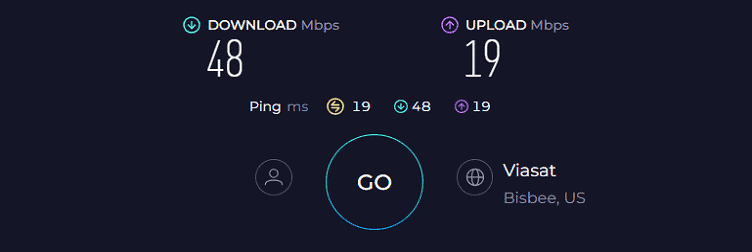
On the first floor when the devices were separated by 40 feet, the router moved to about 29 Mbps and 12 Mbps, respectively.
Over a week of continual use as a primary router, the performance was more than decent. The available bandwidth easily suffices two of your HD streams, provided no other tasks are running in the background. That’s an unreal situation.
Besides, basic internet tasks like cashless transactions, online booking, sending emails, and browsing social media seem like a childsplay.
WiFi Coverage & Devices Capacity
As per the manufacturer, Netgear R6700AX is suitable for apartments, with its value standing at 1,500 Sq Ft. It’s less than its competition but its three-antenna setup easily transmits signals to up to 1,200 Sq Ft.
As generated on the WiFi mapper, the signals in the outskirts stay stable with maximum download speeds of 10-12 Mbps. The device further brings in an OFDMA and beamforming to connect to up to 15-16 smart devices simultaneously.
P.S.: These numbers stand true provided you’re on basic tasks like sending emails, web browsing, and others.
Security Features
As mentioned earlier, the R6700AX comes with a 1-year premium subscription to Netgear Armor. The advanced features available with it are network vulnerability assessment to scan and identify network flaws, manage or block vulnerable devices, anti-theft protection, malware block, and many others.
Post that, you may opt to continue with the subscription or stay protected with basic features like WPA3, VPN, guest network, and auto-firmware updates. These are however best for any household network settings.
Conclusion
All in all, Netgear R6700AX comes at a decent speed and security features much better than other options out there. Besides, the availability of technologies like MU-MIMO and beamforming makes way for stable signals on your smart devices.
Its range might be middling but still, enough to cover any mid to small-sized apartment with ease.
- Wi-Fi 6 support
- 1-year free subscription to Netgear Armor
- Pocket-friendly
- Stable throughput
- Decent device-handling ability
- Middling range
5. Best Mesh WiFi: TP-Link Deco X55
Do you experience WiFi dead zones in your large home? Consider setting up a mesh network with TP-Link Deco X55 to solve the issue.
- Wireless Standard: Wi-Fi 6 (802.11ax)
- Band Frequency: Dual-Band
- WiFi Range: Up to 4,500 Sq Ft
- Number of Devices Supported: 100+
- Ports: 3 x Gig LAN Per Deco
For a large house, mesh routers seem a more convenient option, and TP-Link Deco X55 is the best available at this price.
Aside from a whole home coverage, it boasts a decent throughput & device handling capacity alongside a plethora of networking technologies to extract the most out of your Satellite internet connection.
Speeds & Performance
Deco X55 courtesy of its dual-band Wi-Fi 6 connectivity, boasts a maximum throughput capacity of 3000 Mbps, with its band-wise distribution as follows:
| 5 GHz: 2402 Mbps | 2.4 GHz: 574 Mbps |
With the throughput capacity it presents, any satellite internet package should fare well. So, I tested this mesh setup with the HughesNet 150 Mbps plan, and the performance it delivers stays far ahead of the devices in this range.
To start with, when up close to the main router, I raked over 121 Mbps for downloads and 20 Mbps for uploads.
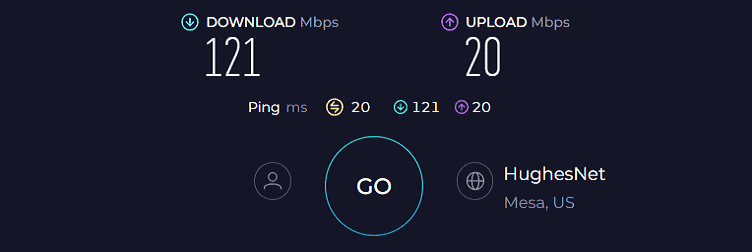
The HD streaming on the first floor was pretty smooth, and the stable internet paved the way for lag-free video calls and meetings.
Moving on to the second floor, 50 feet away from the main router, my test device could achieve respective speeds of around 48 Mbps and 13 Mbps for downloads and uploads. That’s even capable of handling an HD video stream and a Zoom call simultaneously.
But if you need to engage in casual gaming, three Ethernet ports with 1 Gbps speed caps come in handy. With a maximum download speed of 149 Mbps via a wired connection, I can play games like EA FC24, League of Legends, and Fall Guys.
WiFi Coverage & Devices Capacity
Every unit of Deco X55 has two internal beamforming antennas to claim a maximum range of 4,500 Sq Ft, considering you have two units in place. You can further add 2,000 Sq Ft if you include one more node to the mix.
To test its practical capacity, I installed the main router in the basement and the satellite node on the second floor of my house. And I could get stronger signals at pretty much every corner of my two-tier house, spanning over 3,700 Sq Ft.
Moving on, concerning the total device limit, Deco X55 caps to 150, which practically includes all your smart gadgets. I, however, took a fairly conservative approach with the number and could connect 40 smart devices at once.
Beyond 30, one could notice the strain on the system. But overall, there weren’t any lags even when devices were hogging down the internet.
Security Features
The security of X55 is decent with the free version of the HomeShield. With it, you get access to features like WPA3, VPN, guest network, access control, and SPI firewall to protect the data transmitted through the network.
Besides, its parental control feature lets you block any websites manually and limit the time your kids are online.
Conclusion
To conclude, for large houses, the seamless roaming and AI-driven mesh ensure a consistently strong connection. Unless you’re an avid gamer or a Twitch streamer, the processing and hardware capabilities are unlikely to be restrictive.
Thanks to its simple setup, complimentary HomeShield basic, and impressive speeds, you can expect outstanding value for money. For more information, read my in-depth Deco X55 review.
- Extensive WiFi coverage
- Decent throughput
- Excellent device holding capacity
- Easy to install & operate
- Good security features
- No USB port
6. Best Parental Controls: Synology MR2200AC
- Wireless Standard: Wi-Fi 5 (802.11ac)
- Band Frequency: Tri-Band
- WiFi Range: Up to 2,000 Sq Ft
- Number of Devices Supported: 20+
- Ports: 1 x Gig WAN + 1 x Gig LAN
Synology MR2200ac is one of the top parental control routers which boasts multiple upgrades in terms of throughput capacity, range, and other networking techs to boast a much-improved performance than its predecessor.
That’s not it. Its security features protect your satellite network and smart devices from online threats.
Speeds & Coverage
To start with, the maximum theoretical capacity of MR2200AC extends to 2200 Mbps, with speeds on each band distributed as:
| 5 GHz (1): 867 Mbps | 5 GHz (2): 867 Mbps | 2.4 GHz: 400 Mbps |
The MR2200ac performed well in my tests. In comparison to the similarly priced routers, it topped the charts with the Starlink residential plan in place.
In close range, its score of 91 Mbps for downloads and 10 Mbps for uploads is great enough for HD streaming and other basic tasks like browsing the internet, online shopping, and stock trading.
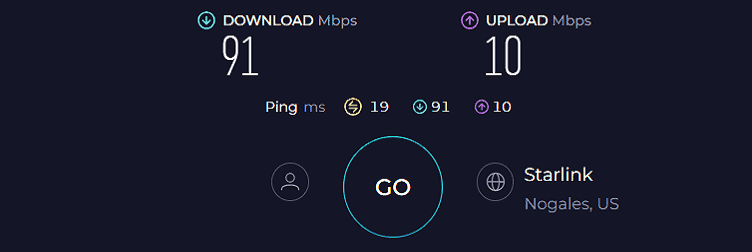
The numbers, however, fell to 46 Mbps and 6 Mbps, signals were stable, and my online tasks didn’t lag once. I stressed it for three days with continuous heavy usage, and it didn’t lag or disconnect once.
WiFi Coverage & Devices Capacity
The MR2200ac is slightly better than my previous pick, Netgear R6700AX. When placed in the middle, I found out that it can cover an average home of some 1,800 Sq Ft with reliable signals to every corner.
The numbers, however, vary from one space to another, but the signals were stable, thanks to its beamforming support. It further instills a mesh tech where you can pair another Synology router to extend its range further to an extra few feet.
Moving on, the device-handling capacity of MR2200ac is less than average. At a time, I could only connect up to 17 smart devices, but signals were stable with MU-MIMO and OFDMA.
Security Features
Synology MR2200ac excels in the realm of security. Straight out of the box, it provides features such as malware and intrusion blocking, scans for potential threats, and blocks malicious websites and apps to safeguard your network and devices from online hazards. The best part is, you don’t need to pay extra for these.
Conclusion
Overall, Synology MR2200ac offers a range of management tools that lets you schedule bandwidth priority, filter website content, monitor usage, and help keep your space safe from malicious cyber attacks.
The installation is simple, and networking technologies like MU-MIMO and beamforming ensure a stable throughput performance.
- Tri-band operation
- Stable network performance
- Advanced security tools & parental controls
- Easy to install and configure
- Supports mesh tech
- Old Wi-Fi standard
- Middling device handling ability
7. Cheapest Option: D-Link DIR-1260
- Wireless Standard: Wi-Fi 5 (802.11ac)
- Band Frequency: Dual-Band
- WiFi Range: Up to 2,000 Sq Ft
- Number of Devices Supported: 25
- Ports: 1 x Gig WAN + 4 x Gig LAN
Last but not least, D-Link DIR-1260 is one of the cheapest options on the market that can be paired with a satellite internet connection. It entails some handy features like a decently powerful processor and a four-antenna setup with a theoretical coverage of 2,000 Sq Ft.
Speeds & Performance
The dual-band Wi-Fi 5 setup in DIR-160 maxes out its speeds at 1200 Mbps, divided over its bands as follows:
| 5 GHz: 867 Mbps | 2.4 GHz: 300 Mbps |
Courtesy of its powerful processor, the performance didn’t have any drops when paired with Starlink residential 100 Mbps plan.
The download and upload speeds for either of the bands weren’t very high, with the 5 GHz band at 20 feet distance clocking 83 Mbps and 15 Mbps.
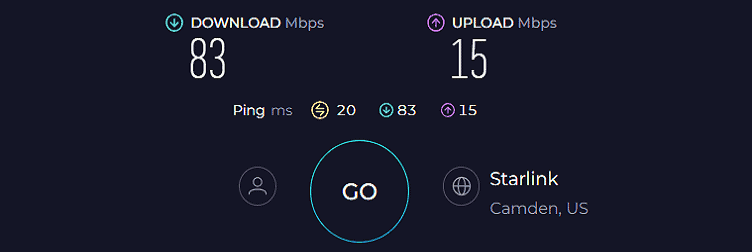
On the other hand, the 2.4 GHz WiFi at around 50 feet fared at 66 Mbps and 6 Mbps. Basic residential tasks should move like a breeze, but if you need a tad higher speeds for your gaming or streaming tasks, establish a wired connection between your device and a router.
WiFi Coverage & Devices Capacity
In my range tests over my grandpa’s 1,500 Sq Ft home, the router performs decently well, as it could encase the entire space with decent signals. I could connect up to 20 devices without producing any jitters or inconsistencies. Thanks to MU-MIMO, it demonstrates a decent multi-device connectivity.
Security Features
Despite being the cheapest offering, it instills the latest WPA3 for enhanced online security. Other than that, features like VPN and access controls add the icing to the cake. You can browse through anything without compromising your identity.
DIR-1260 also achieves a decent score concerning parental controls. You can create separate profiles for your family members monitor the time they are online and pause the internet for a specific member. At this price, it’s a no-brainer!
Conclusion
Overall, the D-Link DIR-160 is a cheap yet highly dependable router to use with satellite internet. It offers a decent range of features that can satisfy most of your household’s requirements. However, it falls short in some aspects, such as security and ports, which places it lower in the rankings.
- Pocket-friendly
- Decent coverage
- Easy to install
- Stable throughput
- Decent security controls
- No USB port
Frequently Asked Questions
While you must use the modem that your satellite internet provider provides, you don’t need any special router to access the internet on your available devices.
Yes, you can replace the router provided by Viasat, HughesNet, or Starlink with your own. Using an alternate or a third-party device should enhance the network performance, provided you have made an informed choice.
According to the FCC, the advanced speeds for downloads and uploads should start at 25 Mbps and 3 Mbps, respectively. You can undertake “light” internet tasks like surfing the internet, streaming HD audio, and others. While for gaming and streaming, you need a good download & upload speed.
– Start by placing it centrally in your house.
– Plug one end of the Ethernet cable into the router and the other into the PC.
– Access the web GUI and complete your setup.
Verdict
The best possible satellite internet router enhances your network’s performance and fulfills your respective needs. I hope my curated list helped you make an informed decision. But if you are confused, here are my final suggestions:
- If you’re paired with the top-tier plan and need a future-proof router that delivers the best performance, get the TP-Link Archer AXE75.
- If you’re subscribed to HughesNet, Linksys Hydra 6 can be a great pick for it.
- If you have a large house to cover TP-Link Deco X55 is a solid mesh WiFi.
- Finally, if you need a cheap option for the most basic internet plan, go for D-Link DIR-1260.
Do let me know in the comments below which models have you gone for. Stay safe and happy networking!








Leave a Reply